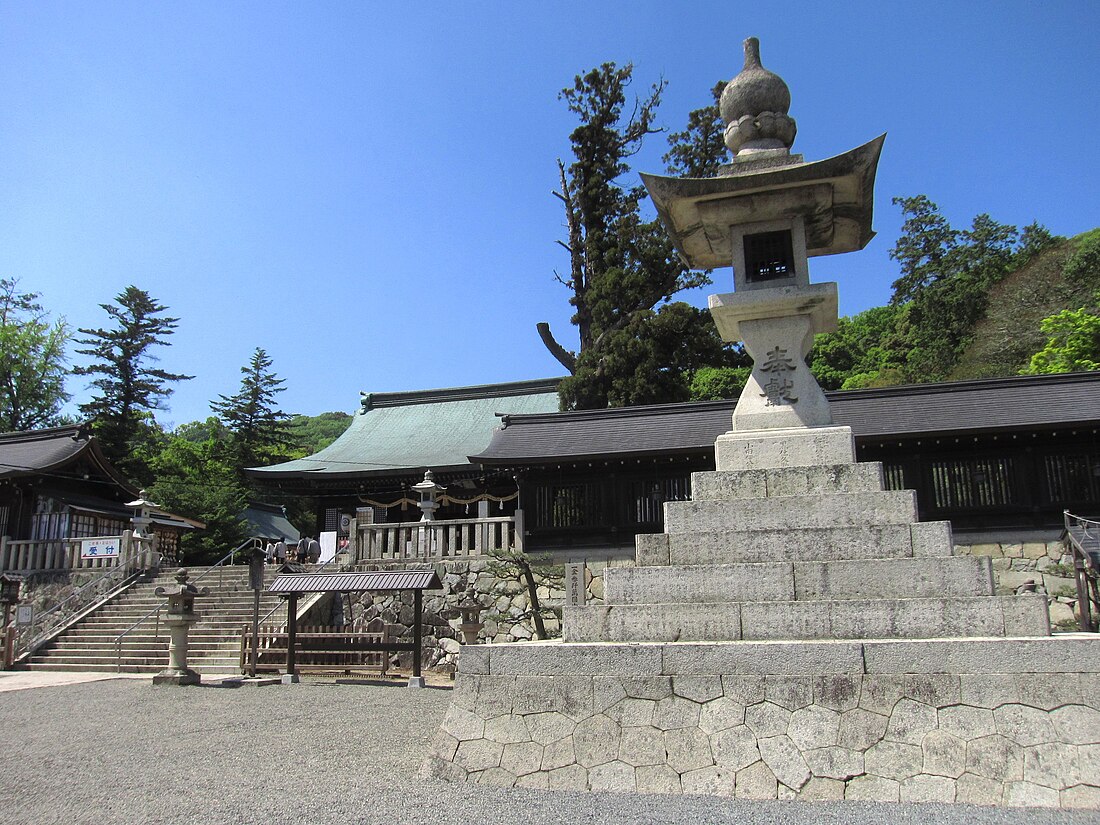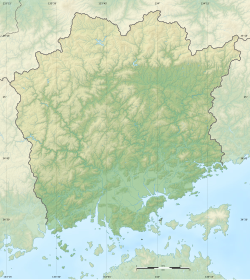Top Qs
Timeline
Chat
Perspective
Kibitsuhiko Shrine
Shinto shrine in Okayama Prefecture, Japan From Wikipedia, the free encyclopedia
Remove ads
Kibitsuhiko Jinja (吉備津彦神社) is a Shinto shrine in the Ichinomiya neighborhood of the city of Okayama in Okayama Prefecture, Japan. It is the ichinomiya of former Bizen Province. The main festival of the shrine is held annually on the third weekend of October. Theshrine is also known in literature as the Asahi-no-miya (朝日の宮).[1]
Remove ads
Location
Kibitsuhiko Jinja is situated at the northeastern foot of Mount Kibi no Nakayama (吉備の中山, Kibi no Naka-yama) in Okayama. Kibitsu Jinja is situated at the mountain's northwestern foot. The headquarters of Kurozumikyō is located on the mountain's summit.[2][3][4][5]
Kibitsuhiko Jinja is located within close walking distance of Bizen-Ichinomiya Station.
Enshrined kami
The kami enshrined at Kibitsuhiko Jinja are:[citation needed]
- Kibitsuhiko-no-mikoto (吉備津彦命), the son of Emperor Kōrei and conqueror of the Kingdom of Kibi
- Wakatakehiko-no-mikoto (稚武彦命), younger brother or son of Kibitsuhiko
- Emperor Kōrei (孝霊天皇)
- Emperor Kōgen (孝元天皇)
- Emperor Kaika (開化天皇)
- Emperor Sujin (崇神天皇)
- Hikosashikatawake-no-mikoto (彦刺肩別命), brother of Kibitsuhiko
- Amatarashi-hiko Kunioshi-hito no mikoto (天足彦国押人命)
- Yamato-totohimo-moso-hime-no-mikoto (倭迹迹日百襲姫命), elder sister of Kibitsuhiko
- Ōyamato-totohiwakaya-hime-no-mikoto (大倭迹々日稚屋比売命), younger sister of Kibitsuhiko
- Kanayamahiko-no-kami (金山彦大神), elder sister of Kibitsuhiko
- Ōyamakuni-no-kami (大山咋神)
Remove ads
History
Summarize
Perspective
The origins of Kibitsuhiko Jinja are uncertain. According to the shrine's legend', it was during the reign of Empress Suiko, and was the site of Kibitsuhiko-no-Mikoto's residence; but the shrine does not appear in any historical documentation until the late Heian period. It is not listed in the early Heian period Engishiki and instead Ani Shrine was given the rank of Myojin Taisha (名神大社) and the rank of ichinomiya of the province. However, Ani Jinja sided with Fujiwara no Sumitomo in his revolt from 939 to 941 and was thus demoted. On the other hand, Kibitsu Shrine, the parent shrine of the Kibitsuhiko Jinja wrote prayers for the victory of imperial forces over Fujiwara no Sumitomo, and was thus rewarded by having their branch shrine in Bizen raised to become the ichinomiya. During the Sengoku period, the shrine was burned down by the Matsuda clan, but was restored with the support of Ukita Naoie. Toyotomi Hideyoshi prayed here for victory prior to his attack on Takamatsu Castle.[6][7]
In the Edo period, Ikeda Toshitaka, the daimyō of Himeji Domain and the lord of Okayama Castle, rebuilt the shrine, and successive rulers of Okayama Domain sponsored various repairs and reconstructions. After the Meiji Restoration, the shrine was listed as a Prefecture Shrine, and was promoted to a National Shrine, 3rd rank (国幣小社, Kokuhei Shosha) in 1928.In December 1930, the main shrine and most other structures (with the exception of the Zuijinmon Gate) burned down due to accident. The shrine buildings that can be seen today were completed in 1936.[6][7]
The shrine is a three-minute walk from Bizen-Ichinomiya Station on the JR West Kibi Line.
Cultural Properties
- Tachi Japanese sword. Edo Period, National Important Cultural Property. Signed by Ikeda Shinkai and dated 1678, this sword was donation to the shrine by Ikeda Tsunamasa, It is now kept at the Okayama Prefectural Museum.[8]
Gallery
- Panorama
- Honden(Okayama P.ICP)
- Haiden
- Zuishin-mon(Okayama C.ICP)
- Stone tōrō lantern(Okayama C.ICP)
- Peace Sugi
- Torii
- Approach
See also
References
External links
Wikiwand - on
Seamless Wikipedia browsing. On steroids.
Remove ads











